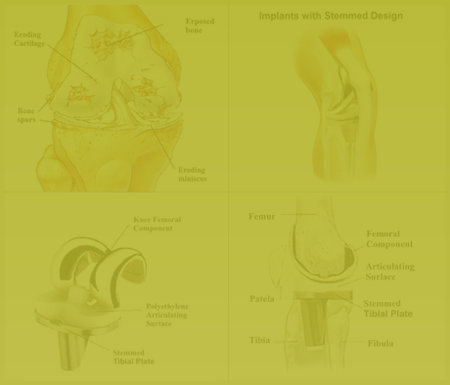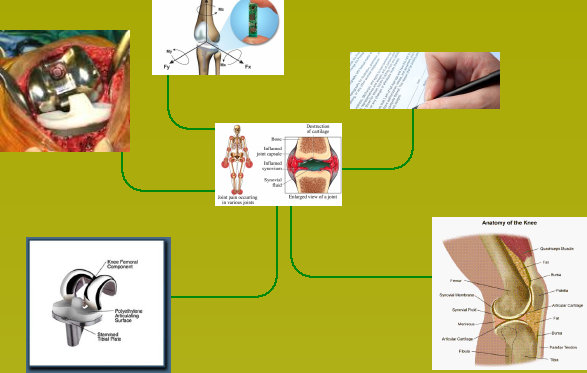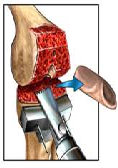
By Gelareh Eslamian

The Knee Joint Replacement Procedure
The artificial joint that replaces the injured segments of the knee is designed very similar to the natural knee joint in order to
help better steadiness and flexibility. The artificial knee joint is similar in size and shape and has similar functionalities as
the natural joint. This is done through an X-ray taken at the time of surgery, which enables the medical professionals to design an
artificial joint with similar configurations. It is then tried on the patients before surgery to see whether it fits on the patients
or not and once the testing is successful subsequent steps are then taken to finally implant the artificial joint in place of the
patientís natural system.



Figure1.Replacing the knee Implant (8)
To attach the knee implant to the bone, specific material known as bone cement is applied, which helps in binding the prosthesis firmly to the bone. Binding the prosthesis to the bone with no cement is also possible; however it is advisable just for younger patients. Besides it is surgeonís decision which method is more appropriate depending upon the technical aspects of every individual case.
Different methods to implant artificial knee joint:
Three different methods are available to implant the synthetic knee joint. Selecting the method completely depends on severity of
deformation:
1) Partial Surface Replacement:
In this kind of replacement, a surface prosthesis is usually fixed on one of the condyles of the femur, and any kind of knee movement
leads the prosthesis to slide on the synthetic disc. This disc is fixed on the other side of the top surface of the tibia with the
help of a plate mostly made of metal. The two preserved ligaments named the collateral and cruciate, help in providing stability to
the knee (11).

Figure2.Partial Surface Knee Replacement (11)
2) Total Surface Replacement
In this case, a surface prosthesis is fixed at the end of the femur. There are two various types of the total surface prosthesis used
for the thigh bone since the outer condyle of the thigh bone is bigger than the inner condyle and also it varies in shape. A metal
based plate and a synthetic disc is fixed on the tibia, which acts as a sliding surface. The procedure by which the metal base plate
is fixed on the femur depends on the condition of the tibia. Also, this prosthesis comes in varied shapes and sizes as the human thigh
bones too are varied in shape and size. The patella too can be replaced with a synthetic plate if there is considerable damage to
its cartilage layer that covers the knee joint and moves downwards and upwards in tandem by the movement of the knee(11).

Figure3.Total Surface Knee Replacement (11)
3) Complete Axial Joint Replacement
In a complete axial joint replacement, the damage caused to the entire knee joint, ligaments as well as cartilage is corrected through
a surgical procedure. In this process, a hinged prosthesis is implanted which links the femur and tibia and holds them together with
the aid of a movable axis. A stem prosthesis is fixed by removing larger areas of old, worn out or damaged bones, into the femur and
tibia.
Methods of Fixing the Artificial Implant to the Bone
There are three various options available to fix the artificial implant to the bone.
1) Cemented Procedure
2)Non Ė Cemented Procedure
3)Hybrid Fixation Procedure
1) In the Cemented Procedure, the artificial implants attached to the bone by using a special type of cement named polymethylmethacrylate
which helps in adjusting the irregularities of the bone. This procedure is highly dependable as it ensures pain free activities for
a minimum of ten years post surgery. One of the major benefits of this kind of implant is that bonding is almost immediate. The small
gaps between the implants and the bone are filled up with cement and this increases the success of this kind of implant to as high
as 95% especially in case of older people who are relatively less active and agile as compared with younger counterparts. This capable
the patients to resume day to day activities like walking and other normal movements of the joint. Moreover, this procedure allows
him/her the required maneuverability and flexibility by putting his/her entire body weight on the newly implanted joints immediately
in the post surgery period.
2) The non cemented procedure, on the other hand is considered as more viable and better in comparison to the cemented procedure as
it uses components made of rough porous surface. When the porous surface implant is fixed in close contact with the bone, it gives
the bones enough space to let them grow from within, thereby eliminating the need for the use of polymethylmethacrylate or cement
altogether. Although the time required in healing in this type of implant is longer as compared to the cemented procedure, once the
bonding is properly in place it is considered relatively stronger and long- lasting than cement (19).
3)As the name itself suggests, the hybrid fixation procedure, uses a combination of cemented as well as non cemented procedure whereby
only the tibia component is cemented leaving the femoral component as it is.
Possible Risks and Complications
The knee implant surgery is relatively quite safer and less complicated as compared to other types of surgeries. However complications
and risks are a part of the most minor surgeries. The following complications might arise post surgery (17) :
1) Blood-clots
It happens most commonly in the post operative stage of the surgery. It is generally not a harmful symptom as long as the blood clots remain restricted to the leg.However, if it reaches to the lungs through the heart then it might cause serious difficulties, occasionally leading to death of the patient, if not cured properly. The formed blood clots (thrombosis) cause pain and swelling in the leg. Therefore, patients should follow some special procedures like using pressure stockings, moving the leg at an appropriate time after knee surgery to avoid blood clotting.
2) Infection
Infection is a relative harmful complication, since harmful substances like bacteria may enter into the open wound, ultimately leading to the removal of the knee implant. Therefore patients who will go through the knee replacement surgery should take antibiotics before and even after the surgery.
3) Implant loosening
Most implants last up to approximately 20 years after surgery depending on individual case, but irrespective of that, it still wears out after a specific period of time. One of the reasons leading to the loosening of the knee implant could be level of activities such as weight lifting, and running that cause too much stress and pressure on the knee joint. This is observed typically in case of younger patients who exert more stress on the knee joint owing to their age and lifestyle. The weight of the patient is also important. For instance, if the patient is over weight or obese then it would lead to a greater load on the knee joint leading to increased chances of implant loosening.
4) Stiffness
The human bodyís usual healing process leads to contraction of scars during the post surgery period. In this case, the
skin in the knee region gets contracted and hence more stiff leading to restricted movements of the knee. Thus patients should start
physical therapy shortly after surgery.
5) Excessive Bleeding
Bleeding complications may arise several days after the surgery as a result of use of thinners during surgery. Excessive blood loss is a cause of serious concern and may lead to re-opening of the wound to repair the damage.
6) Stress Shielding
Stress shielding is known as the major reason of the bone degeneration. The metals being used in knee implant cause
stress shielding .Metals contain high strength, therefore; in the knee implant the applied metal experiences a lot of load on itself,
which results in decreasing the amount of load born by the tissue near the joint. Decreasing the stress on the bone results in reducing
the bone density and that point creates problems in the tissue-implant interface (2).






